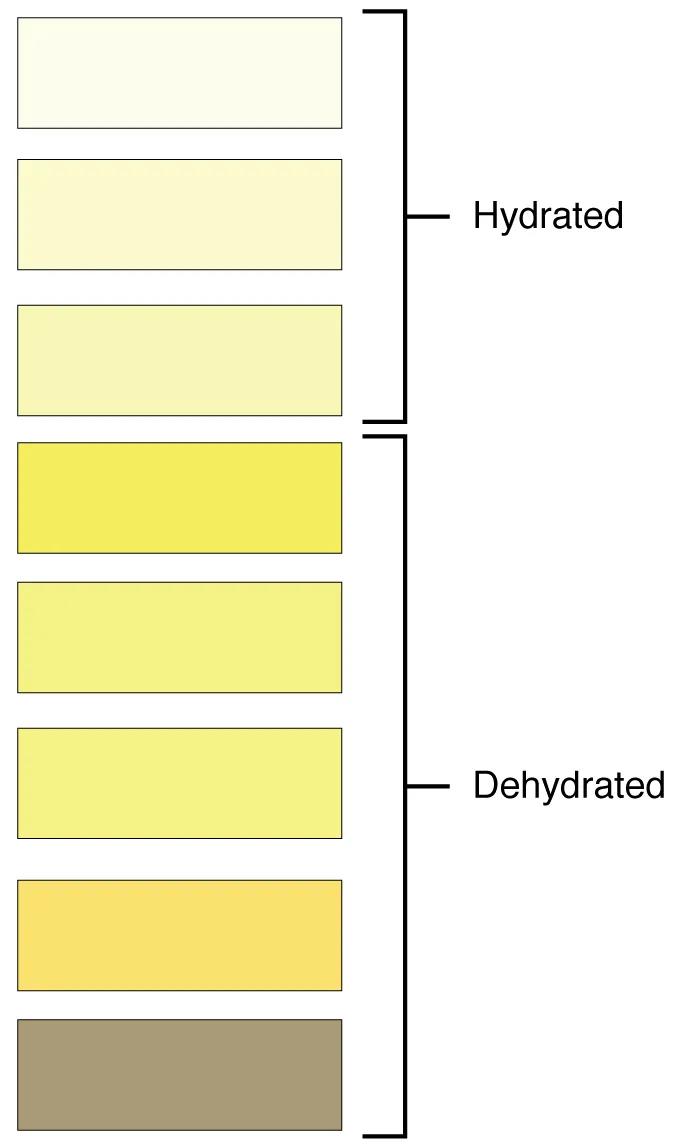Discover what your urine color reveals about your hydration status and overall health. This article explains how the shades of yellow in the urine color diagram can serve as a quick, non-invasive indicator, guiding you on maintaining optimal fluid balance.

The Body’s Report Card: What Your Urine Color Tells You
Urine is more than just a waste product; it serves as a valuable, real-time report card from your body, offering insights into your hydration status and overall health. The color of your urine, ranging from clear to dark amber, is primarily determined by a pigment called urochrome (or urobilin) and the concentration of solutes in the urine. While often overlooked, observing urine color is a simple, non-invasive way to monitor your fluid intake and detect potential underlying health issues.
This visual guide provides a clear spectrum of urine colors, categorized by hydration levels. Understanding this spectrum empowers individuals to make informed decisions about their fluid intake and recognize when further medical attention might be necessary. It’s a fundamental aspect of self-care and a vital sign that your urinary system is functioning correctly.
Key indicators from urine color:
- Hydration status
- Concentration of waste products
- Potential signs of underlying health conditions
These insights help individuals proactively manage their well-being.
Decoding the Urine Color Spectrum
The provided diagram offers a visual guide to interpreting urine color, primarily focusing on hydration levels.
Hydrated: This category encompasses lighter shades of urine, typically very pale yellow or clear. It indicates that an individual is well-hydrated, meaning they are consuming sufficient fluids to meet their body’s needs. The kidneys are effectively processing excess water and waste, resulting in dilute urine.
Dehydrated: This category includes darker shades of yellow, amber, and even brownish tones. It signifies that an individual is not consuming enough fluids, leading to concentrated urine. The body is attempting to conserve water, resulting in fewer fluids being excreted.
The Science Behind Urine Color
The normal yellow hue of urine is attributed to urochrome, a pigment produced from the breakdown of hemoglobin. The intensity of this yellow color is directly related to the concentration of urochrome and other solutes in the urine. When you drink plenty of fluids, the urine becomes more dilute, making the yellow pigment less noticeable, hence the lighter color. Conversely, when fluid intake is low, the kidneys conserve water, making the urine more concentrated and thus darker.
Hydrated: Pale Yellow to Clear
When you are well-hydrated, your urine will typically be very pale yellow, light straw-colored, or even clear. This indicates that your body has a healthy balance of fluids, and your kidneys are efficiently filtering waste products while excreting excess water. Maintaining this level of hydration is crucial for numerous bodily functions, including nutrient transport, temperature regulation, and joint lubrication. Consistently clear urine, however, might sometimes indicate over-hydration, which can dilute electrolytes and potentially lead to hyponatremia, though this is less common than dehydration.
Dehydrated: Dark Yellow to Brownish
As fluid intake decreases, the urine becomes more concentrated, and its color deepens from dark yellow to amber or even brownish. These darker shades are clear indicators of dehydration, meaning your body is not getting enough water. Prolonged dehydration can lead to fatigue, headaches, dizziness, and more serious health complications like kidney stones, urinary tract infections, and heat stroke. The body’s natural response to dehydration is to conserve water, leading to less water being excreted with the waste products, hence the concentrated, darker urine. In severe cases, very dark brown or tea-colored urine can indicate extreme dehydration or even more serious underlying issues like liver disease or rhabdomyolysis, requiring immediate medical attention.
Beyond Hydration: Other Factors Influencing Urine Color
While hydration is the primary determinant, other factors can influence urine color, making it a valuable diagnostic clue.
- Diet: Certain foods, like beets (which can cause reddish urine) or carrots (orange), and food dyes can alter urine color.
- Medications: Many medications can change urine color, ranging from bright orange (e.g., phenazopyridine for UTIs) to blue or green (e.g., certain multivitamins or antidepressants).
- Vitamins: High doses of B vitamins, especially riboflavin (B2), can turn urine a bright, fluorescent yellow.
- Medical Conditions:
- Red or Pink Urine: Often indicates the presence of blood (hematuria), which can be a sign of urinary tract infections, kidney stones, kidney disease, or, less commonly, bladder or kidney cancer.
- Orange Urine: Can be due to dehydration, certain medications, or liver/bile duct problems.
- Blue or Green Urine: Can result from certain dyes, medications, rare genetic conditions, or bacterial infections.
- Dark Brown or Tea-Colored Urine: May indicate severe dehydration, liver disease (jaundice), or muscle breakdown (rhabdomyolysis).
- Cloudy Urine: Often suggests a urinary tract infection, kidney stones, or excessive protein.
Any unusual or persistent change in urine color, especially if accompanied by other symptoms like pain, fever, or foul odor, warrants a consultation with a healthcare professional to rule out underlying medical conditions.
Conclusion
The color of your urine serves as a remarkably straightforward yet informative indicator of your body’s hydration status and overall health. From the pale yellow shades signifying optimal hydration to the darker tones signaling dehydration, paying attention to this daily bodily function empowers individuals to make proactive choices for their well-being. While diet, medications, and vitamins can influence its appearance, persistent or unusual changes in urine color should always prompt a medical evaluation to ensure proper diagnosis and timely intervention, underscoring its role as a vital diagnostic clue.

